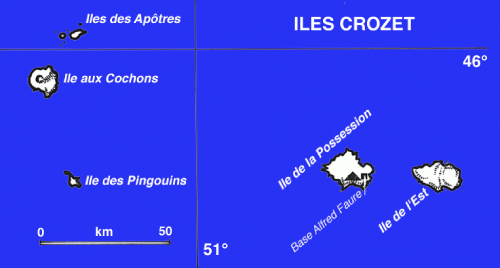

Location
| IAGA code | : | CZT | |
| Location | : | Crozet Archipelago, Possession Island, Base of Alfred Faure | |
| Organisation | : | Ecole et Observatoire des Sciences de la Terre (EOST) | |
| Co-latitude | : | 136,431° | |
| Latitude | : | 46,431°S | |
| Longitude | : | 51,860°E | |
| Elevation | : | 160 meters |
Instruments
| Absolute Instruments | : | Theodolite Zeiss + fluxgate probe (Bartington MAG01H) |
| Variometers | : | triaxial fluxgate variometer (Thomson VFO 31) proton precession scalar magnetometer (GSM90). |
Recording
| Orientation | : | HDZF |
| Dynamic Range | : | +/- 1000 nT |
| Resolution | : | 0,1 nT |
| Internal Sampling Rate | : | 0.1 sec |
| Data Sampling Rate | 1 sec | |
| Filter | : | 47 points (Gaussian) digital filtering conforms to Intermagnet specification |
| K-indices | : | FMI-method K9 - limit : 500 nT |
INTERMAGNET
| GIN | : | PARIS |
| Transmissions | : | via Email every 12h U.T. |
Key dates
| 13 January 1772 | : | Discovery of Crozet Archipelago by the French Explorer Nicolas Marion Dufresne. |
| 1929-1931 | : | first known magnetic measurements on the site of American Bay by the expedition of B.A.N.Z. led by Sir Douglas Mawson. |
| 1963 | : | settlement of the base Alfred Faure on Possession Island |
| January 1974 | : | settlement of the magnetic observatory |
History
The Possession island (150 km2),that belongs to the oriental part of Crozet archipelago, is a complex strato-volcano. The Alfred Faure base, eastward of the Possession Island, is situated on a plateau sloping towards the sea. This plateau is composed of a series of detrital volcanic units produced by the erosion of olivine and pyroxene bearing lava flows.
The magnetic station of Port Alfred, opened in 1964, was first exclusively aimed at the study of earth magnetic pulsations and micropulsations . From 1972 onwards, the necessary equipment for a permanent magnetic observatory was gradually put in. The Port Alfred magnetic observatory (IAGA code CZT),located in the eastern part of the Possession Island was finally opened in 1974.
The observatory comprises two shelters : an absolute house, which is a light structure, made with resine material,and a variometer concrete house, with very stable temperature, but unfortunately built with magnetic sand from the island. The variometer house is located 40 meters east to the absolute house. The recording laboratory is 350 meters SE away from the absolute house.
Digital one minute data have been continuously recorded since 1974. An equipment for the INTERMAGNET program was added in February 1991. It included a data collection plateform (DCP) for transmission via METEOSAT satellite to European Gin's.
Since March 29th 2010, new 1Hz Acquisitions Systems (M.A.R.Cell 1.0- Magnetic Acquisition and Recording Cell 1.0) were installed.
Absolute Measurements
The absolute pier (46.431 S, 51.860 E) has been the same since 1974.
Absolute measurements are performed on average every tow days using the Declination-Inclination magnetometer D-IMAG88. This D-I flux is based on a Zeiss 010B non-magnetic theodolite fitted with a single axis sensor mounted on the telescope. Total field determinations are performed every 10 seconds with a proton Overhauser magnetometer SM90R. The accuracy of the absolute determinations is estimated at +/- 1 nT for H and Z, and the equivalent of 1 nT for D.
Variometers
The fluxgate variometer (VFO31) and the proton Overhauser magnetometer (SM90R) recording total intensity F are placed in the variometer shelter which is heated at a constant temperature of 16 degrees. The triaxial variometer has a nominal output of 5 mV/nT and a dynamic of +/- 1000 nT. The long-term stability of the three-component variometer is better than 1nT/month.
Accuracy of data
The adopted baseline values are calculated by spline smoothing. The uncertainty in the adopted baseline values,
as well as in the final 1-minute values, is estimated less than +/- 2 nT for all elements.
As Port Alfred observatory is on a volcanic island the local magnetic anomalies are very large and with short wave
lengths. The variations of the Port Alfred base lines reflect the time varying local gradient between the absolute measurements pier and the variometer pier, due to the temperature dependant magnetic properties of the rocks.
Reference of the data
Detailed description of the instrumentation and method of data reduction are given in the annual bulletin of the Bureau Central de Magnetisme Terrestre (B.C.M.T., Paris).
